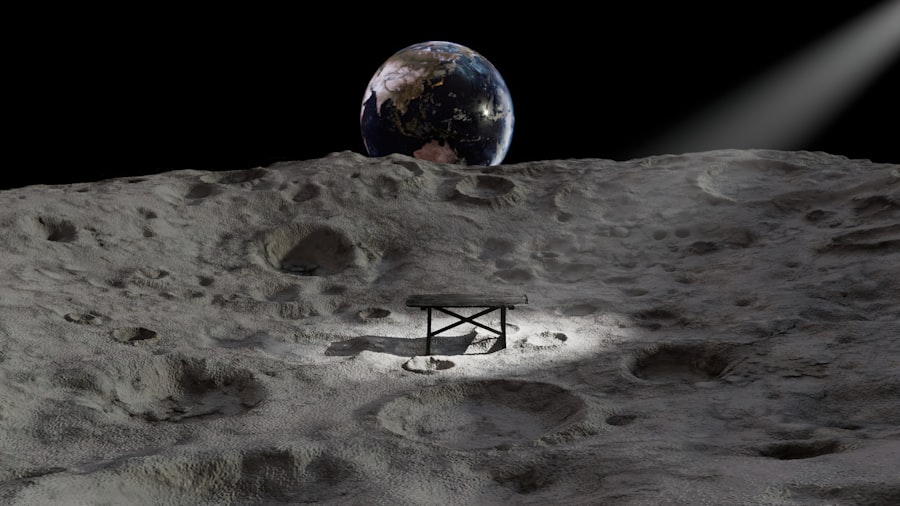The Space Race, a defining aspect of the Cold War, was characterized by intense competition between the United States and the Soviet Union. This rivalry was not merely about technological superiority; it was a manifestation of ideological conflict, with each superpower seeking to demonstrate its prowess on a global stage. The launch of Sputnik by the Soviet Union in 1957 marked the beginning of this fierce competition, igniting fears in the United States about falling behind in scientific and military capabilities.
The race to conquer space became a symbol of national pride and technological advancement, with both nations pouring resources into their respective space programs. As the Cold War progressed, the stakes of the Space Race escalated. The successful landing of Apollo 11 on the Moon in 1969 by the United States was a monumental achievement that not only showcased American ingenuity but also served as a powerful propaganda tool against the backdrop of a divided world.
The Moon landing was more than just a scientific milestone; it was a clear statement of American dominance in the face of Soviet challenges. This rivalry fueled advancements in various fields, including rocketry, telecommunications, and materials science, laying the groundwork for future explorations beyond Earth.
Key Takeaways
- The Space Race and Cold War Rivalry fueled the competition between the US and the Soviet Union to achieve lunar missions.
- Early Plans for Lunar Missions involved both countries exploring the possibility of using nuclear propulsion technology.
- The Development of Nuclear Propulsion Technology was a key focus for both the US and the Soviet Union in their quest for lunar exploration.
- The US Project Orion was a significant effort to develop nuclear propulsion for lunar missions.
- The Soviet Nuclear Lunar Program also aimed to use nuclear propulsion for lunar exploration, leading to international concerns and opposition.
Early Plans for Lunar Missions
In the early years of space exploration, both the United States and the Soviet Union developed ambitious plans for lunar missions. The U.S. program, initially focused on achieving manned spaceflight, quickly evolved to include lunar exploration as a primary goal.
NASA’s Apollo program emerged as a response to the Soviet achievements in space, with President John F. Kennedy famously declaring the goal of landing a man on the Moon before the end of the 1960s. This ambitious objective galvanized public support and mobilized vast resources toward lunar exploration.
Simultaneously, the Soviet Union was not idle. They had their own plans for lunar missions, which included both robotic landers and crewed missions. The Soviet Luna program achieved several significant milestones, including the first human-made object to reach the Moon and the first successful soft landing on its surface.
However, internal challenges and shifting priorities ultimately hindered their ability to match the U.S. in crewed lunar exploration. Despite these setbacks, the early plans laid by both nations set the stage for an era of unprecedented scientific discovery and technological innovation.
The Development of Nuclear Propulsion Technology

As ambitions for deep space exploration grew, so did interest in developing advanced propulsion technologies. Nuclear propulsion emerged as a promising solution to overcome the limitations of conventional chemical rockets. The potential for nuclear thermal propulsion systems to provide greater efficiency and thrust made them an attractive option for long-duration missions, particularly those aimed at reaching distant celestial bodies like Mars or even beyond.
Researchers began exploring various designs that could harness nuclear reactions to propel spacecraft. The development of nuclear propulsion technology was not without its challenges. Engineers faced numerous technical hurdles, including safety concerns related to radiation exposure and the complexities of integrating nuclear systems into spacecraft designs.
Nevertheless, significant progress was made during the 1960s and 1970s, with various prototypes being tested. These advancements sparked discussions about the feasibility of using nuclear propulsion for lunar missions, as well as for future endeavors in interplanetary travel.
The US Project Orion
| Metrics | Data |
|---|---|
| Launch Date | 2025 |
| Estimated Cost | 6 billion |
| Propulsion System | Nuclear Pulse Propulsion |
| Destination | Mars |
One of the most ambitious projects in nuclear propulsion was Project Orion, initiated by the United States in the late 1950s. This innovative concept involved using nuclear explosions to propel a spacecraft through space, effectively creating a series of controlled detonations behind a massive vehicle equipped with a pusher plate. The idea was revolutionary; it promised to achieve unprecedented speeds and reduce travel time for missions to the Moon and beyond.
Despite its potential, Project Orion faced significant opposition from various quarters. Concerns about nuclear fallout and the environmental impact of detonating nuclear devices in Earth’s atmosphere raised ethical questions that could not be easily dismissed. Additionally, as international treaties began to emerge regarding nuclear testing, the feasibility of Project Orion diminished.
Ultimately, while it represented a bold vision for space travel, Project Orion was shelved in favor of more conventional propulsion methods.
The Soviet Nuclear Lunar Program
Parallel to Project Orion, the Soviet Union pursued its own nuclear lunar program, which aimed to develop advanced propulsion systems for crewed missions to the Moon. The Soviets explored various concepts that included nuclear thermal rockets and other innovative technologies designed to enhance their capabilities in space exploration. Their efforts were driven by a desire to regain momentum in the Space Race after falling behind in crewed lunar landings.
The Soviet program faced its own set of challenges, including resource allocation and political pressures that often dictated scientific priorities. Despite these obstacles, they made notable advancements in nuclear propulsion technology and conducted several tests that demonstrated its potential viability. However, as with their American counterparts, changing political landscapes and shifting priorities ultimately led to a decline in focus on nuclear propulsion for lunar missions.
International Concerns and Opposition

The pursuit of nuclear propulsion technology for space exploration raised significant international concerns and opposition from various groups. Environmentalists voiced apprehensions about the potential consequences of launching nuclear-powered spacecraft into orbit or detonating nuclear devices in space. The fear of accidents leading to radioactive contamination was a pressing issue that could not be ignored.
Moreover, anti-nuclear activists highlighted the ethical implications of using nuclear technology in space exploration. They argued that investing in such programs diverted resources from more peaceful scientific endeavors and raised questions about humanity’s responsibility toward preserving both Earth and outer space environments. As public awareness grew regarding these issues, pressure mounted on governments to reconsider their nuclear ambitions in favor of safer alternatives.
The End of Lunar Nuclear Ambitions
By the late 1970s, both the United States and Soviet Union began to scale back their ambitions for nuclear-powered lunar missions. A combination of factors contributed to this shift: changing political climates, budget constraints, and growing public opposition to nuclear technology played significant roles in redirecting focus toward more conventional methods of space exploration. The Apollo program concluded with Apollo 17 in 1972, marking a significant reduction in U.S.
Similarly, the Soviet Union’s lunar program faced setbacks that ultimately led to its abandonment. As resources were reallocated toward other priorities within their space program, interest in crewed lunar missions waned.
The end of these ambitious plans marked a turning point in space exploration history, as both nations shifted their focus toward robotic missions and international collaboration rather than competing against one another.
Legacy and Impact on Space Exploration
The legacy of nuclear propulsion ambitions during the Space Race is multifaceted. While neither superpower achieved its goal of using nuclear technology for crewed lunar missions, their efforts laid important groundwork for future advancements in space exploration. The research conducted during this period contributed significantly to our understanding of propulsion systems and opened avenues for future innovations.
Moreover, the competition between the United States and Soviet Union fostered an environment ripe for collaboration in later years. As both nations recognized the value of working together rather than against each other, international partnerships began to emerge in space exploration efforts. This shift ultimately paved the way for collaborative projects like the International Space Station (ISS), demonstrating that shared goals could lead to greater achievements than rivalry alone.
Contemporary Space Exploration and Nuclear Propulsion
In recent years, interest in nuclear propulsion has resurfaced as humanity looks toward deeper space exploration once again. With plans for missions to Mars and beyond gaining traction, scientists are revisiting concepts that were once shelved during the Cold War era. Advances in technology have made it possible to explore safer methods of harnessing nuclear energy for propulsion while addressing previous concerns regarding safety and environmental impact.
Contemporary discussions surrounding nuclear propulsion are informed by lessons learned from past endeavors. Researchers are now focusing on developing systems that prioritize safety while maximizing efficiency for long-duration missions. As humanity prepares for ambitious goals like establishing a human presence on Mars or exploring asteroids, nuclear propulsion may play a crucial role in making these dreams a reality.
Ethical and Environmental Considerations
As interest in nuclear propulsion technology grows once more, ethical and environmental considerations remain at the forefront of discussions surrounding its use in space exploration. Advocates argue that harnessing nuclear energy could provide sustainable solutions for long-term missions while minimizing reliance on traditional fuel sources that contribute to environmental degradation on Earth. However, critics caution against overlooking potential risks associated with launching nuclear-powered spacecraft into orbit or utilizing nuclear reactions in space environments.
The specter of accidents leading to contamination or unintended consequences looms large over any proposed initiatives involving nuclear technology. As such, thorough assessments must be conducted to ensure that ethical considerations are prioritized alongside technological advancements.
Future Prospects for Lunar Nuclear Ambitions
Looking ahead, prospects for lunar nuclear ambitions remain uncertain yet intriguing. As nations around the world continue to invest in space exploration initiatives, there is potential for renewed interest in utilizing nuclear propulsion systems for future lunar missions. Collaborative efforts among international partners could pave the way for innovative solutions that address previous concerns while advancing humanity’s understanding of our solar system.
The future may hold exciting possibilities as advancements in technology continue to evolve alongside growing awareness regarding ethical implications and environmental responsibilities. By learning from past experiences while embracing new ideas, humanity stands at a crossroads where it can redefine its approach to exploring not only our Moon but also distant worlds beyond our own—potentially reigniting ambitions once thought lost amidst Cold War rivalries.
In the midst of the Cold War, both the United States and the USSR explored ambitious plans to establish nuclear bases on the Moon, a testament to the era’s intense geopolitical rivalry and technological competition. These lunar nuclear plans were part of a broader strategy to assert dominance in space, which was seen as the new frontier for military and scientific advancement. For more insights into the historical context and implications of these plans, you can read a related article on the topic by visiting this page.
WATCH THIS! 🤯America Tried to Nuke the Moon
FAQs
What were the US and USSR lunar nuclear plans?
The US and USSR both had plans to use nuclear weapons on the moon during the Cold War as a show of strength and technological prowess.
When were these plans developed?
The plans were developed in the late 1950s and early 1960s during the height of the space race between the US and the USSR.
Why did the US and USSR consider using nuclear weapons on the moon?
Both countries saw the moon as a potential battleground and wanted to demonstrate their military capabilities and dominance in space.
Did these plans ever come to fruition?
No, the plans were ultimately abandoned due to international treaties and concerns about the potential consequences of nuclear explosions on the moon.
What were the international reactions to these plans?
The plans were met with widespread international condemnation and raised concerns about the militarization of space and the potential environmental impact of nuclear explosions on the moon.
What are the current international laws regarding the use of nuclear weapons in space?
The Outer Space Treaty, which was signed in 1967 by the US, USSR, and other countries, prohibits the placement of nuclear weapons or any other weapons of mass destruction in orbit around the Earth or on celestial bodies.
